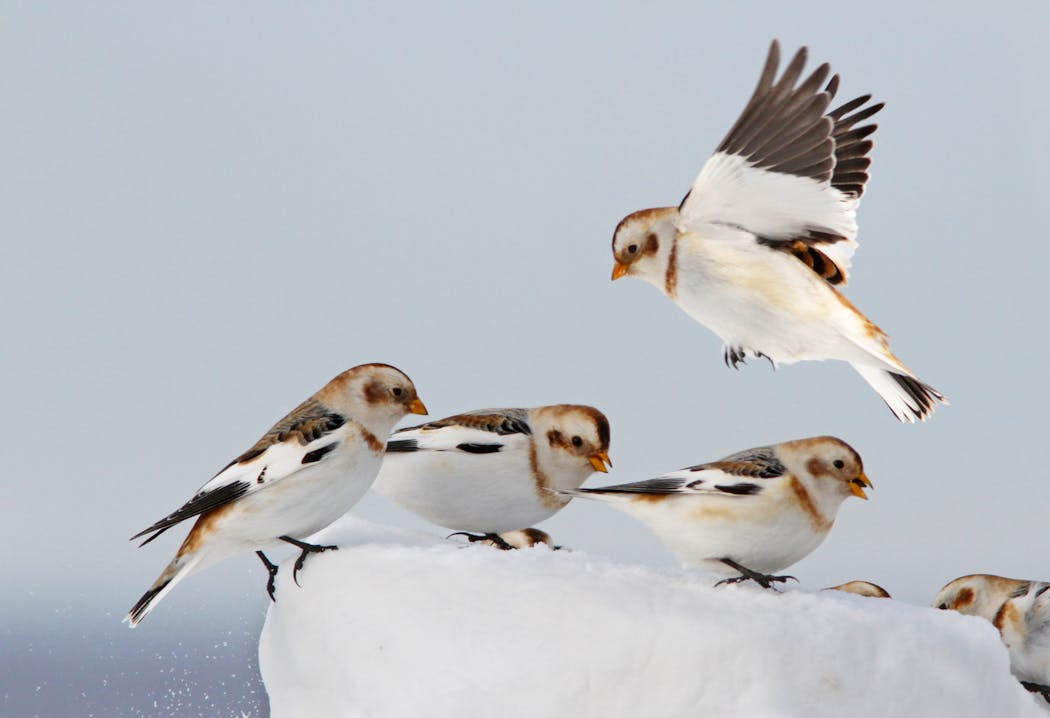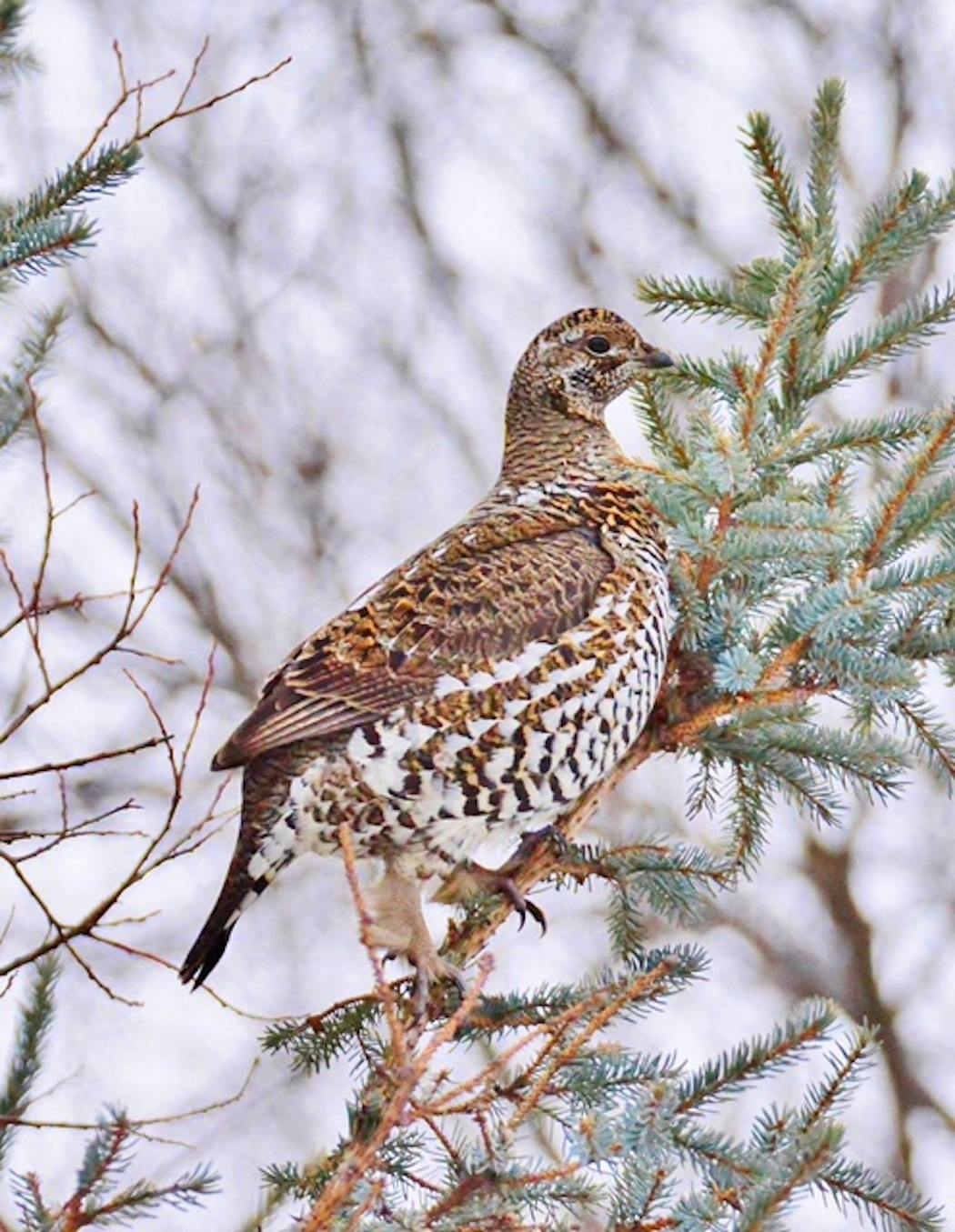Depending on where you plant a foot in Minnesota, you might see an abundance of snow buntings moving through a grassy field or be surprised by the presence of a red-shouldered hawk or little tufted titmouse, a member of the chickadee family. And, undoubtedly, the ubiquitous rock doves and American crows will be on-scene.
The Christmas Bird Count (CBC) means to account for as many of them and a variety of other species as possible before it concludes Jan. 5 — like it has every winter for the past 120 years. The first was Christmas Day in 1900. Minnesota got involved beginning in 1905, with the first counts in Minneapolis and Red Wing.
"This essentially is the largest citizen-science project in the world," said Steve Weston, who has coordinated (and tabulated) the work of state counters for the Minnesota Ornithologists' Union (MOU) since 2013.
The CBC isn't news to birders, or even tired news. In fact, the count might be more valuable than ever with the specter of a warming planet and other threats to keeping birds alive.
The CBC begins Dec. 14 each year. Minnesotans are about midstride this year in their census work, with many opportunities to count birds across the state remaining.
The count's data will update a National Audubon Society database built over decades, informing conservationists, wildlife scientists and others who track the health, breeding and migratory patterns of birds. The data has been used in myriad studies, government reports and peer-review publications.
The count's origin goes back to an ornithologist bent on counting birds rather than focusing on their hunt. It's built on a simple but specific model, on repeat the same day year to year. Each count takes place in a predetermined circle 15 miles in diameter, and each "count circle" has a volunteer compiler who assigns where their volunteers will venture to count every bird they see or hear in a single day. The compiler then tabulates the data from his or her charges. Some Minnesota counters have volunteered in one area or multiple circles for decades.
From Roseau to Austin and scattered in between, Minnesota has 86 count circles this year, contributing to upward of 2,600 counts worldwide if recent history holds. Compilers will send their data reports on to Weston, the coordinator, who later in winter will submit his state CBC summary to the Audubon Society.
Experiences afield
Weston also coordinates volunteers and is the compiler at the Cedar Creek Bog, which encircles the Bethel area. Its count was Dec. 19. Weston has been a part of it since 1999 and is indicative of many Minnesota CBC compilers and volunteers. They've been at it for the long haul. Long enough, too, to have witnessed unusual reports of birds where they are least expected in early winter or to have observed stark fluctuations among typical species.
Last year, for example, was the third year of a report of a broad-winged hawk, a raptor that typically has left Minnesota by October for its winter in South America. Two previous reports were checked and dismissed, but this report, from the Bloomington count circle, was verified through a photograph.
This year, so far, there are two more reports of a broad-winged hawk to investigate, Weston said. "These birds are totally out of place," he added. "Are they good sightings? Yes. Will they be accepted? We'll see."
Beth Siverhus and Kris Guggisberg have been co-compilers for the past five years for the Roseau count circle, and they've volunteered in it for more than 25 years. Siverhus said the year-to-year count of snow buntings, a winter songbird that is a bit smaller than a robin, is an "interesting phenomenon" that speaks to the variables in play each year, such as weather and food sources.
"Looking back, we had 3,103 snow buntings in [2018] and over 1,000 birds in '14 and '19," Siverhus said in an e-mail to the Star Tribune. "When we have high numbers like this, they are in huge flocks feeding in windswept fields with short grasses and seed heads visible. I have often wondered what seeds they are finding so appealing."
Weston sized up the experience — which for some is part of the appeal.
"Sometimes the weather is great and the birds are lousy," he said, "and sometimes the weather is lousy and the birds are great."
Sara Holger, an interpretive naturalist at Whitewater State Park, has been helping with the count since 2012 and will compile and report this year's census in the Whitewater River circle. It's happened every New Year's Day since 1996.
Holger said over time there have been surprising reports of robins, bluebirds and red-winged blackbirds seen near the springs and open-water streams. Also a few species such as the snow bunting, Lapland longspur and horned lark, which are more typical in northern counts. Most common at Whitewater are house sparrows, rock doves, European starlings and crows.
People power
The number of volunteers at each of Minnesota's circles varies. For example, Roseau averages a bit more than seven, while some traditionally have dozens. For example, Henderson had the most participants in 2018 at 114 (60 afield and 54 watching bird feeders). Overall, the state has averaged about 1,400 participants the past four years.
Bottom line: New participants are enthusiastically encouraged.
Siverhus, of Warroad, and Guggisberg, of Roseau, are thinking of ways to lower any barrier in Roseau. They are hoping to attract more people to watch feeders. The count is Jan. 2 each year.
"I think people may shy away from volunteering because they assume it is an all-day commitment, not realizing that any amount of time spent watching a feeder and recording the birds seen is valuable information," Siverhus said.
While there is evidence that the COVID pandemic has brought in new helpers looking to try something new in the outdoors, Weston said he doesn't anticipate a lasting uptick that will stem the "graying out" of regular bird watchers. Some counts in rural Minnesota are down to four people. Audubon recommends at least 10 per count circle. Younger people are involved, but their numbers aren't rising.
"There are a nice corps of young people, but it might be 20 percent of what it was 20 years ago," Weston said.
Holger, in Whitewater, said her count draws heavily from the Zumbro Valley Audubon Chapter in Rochester and the Winona Bird Club, some of whose members have counted birds since the first year, 1996. The upside of more volunteers? It's likely more birds will be spotted or heard, contributing to a more robust and revealing census over time.
Weston, who also has been an MOU member for 30 years, said the CBC over time underscores bird studies. In autumn of 2019, a team led by researchers at the Cornell Lab of Ornithology found that wild bird populations in the United States and Canada had declined by almost 30% since 1970 — a loss of 2.9 billion birds.
A friend had asked Weston at the time if he'd read the study.
"I told him I didn't have to read the report," Weston said. "Because I know it. I am seeing it."
Weston said he takes into account that some species aren't naturally present during early winter in Minnesota, but a truth is that the number of birds has slid over time. One barometer: The number of census-takers has remained relatively constant, but the number of birds they report has declined.
"If you look at birds versus participants for the last 20 to 30 years, almost every species is disappearing," he said, citing fewer cardinals as one notable example.
How to help count birds
There are count circles across Minnesota between now and Jan. 5 that the public can investigate: where the circle is, historical data, how to register to count, and compiler contact information. For example, Up North, Beltrami Island on Dec. 31; Baudette, Jan. 1; Roseau, Jan. 2. Siverhus said many who participate in her count also volunteer at the Baudette and Beltrami Island CBCs, and most are from out of town. But they are committed — a marker of why the CBC has endured.
Go online to MOU's website (moumn.org/CBC/) to learn a history of the count and see a calendar of upcoming count circles and their locations. Click on MN CBC Locations to see a state map and deeper resources to get involved.
Holger emphasized that more people covering more ground means a more accurate accounting of birds in the region.
"Our counts in the Whitewater River Valley vary from year to year. Usually, there is a correlation between how many volunteers we have," she said. "The weather on count day also plays a part, but when we have more volunteers we tend to see more birds."
In addition to contributing to a collective good, the CBC volunteers spoke of the sense of community and wonder, too, even in trying conditions. Siverhus recalled a blustery day when she spotted a short-eared owl hunting low over a field — "Persistence pays off!"
Weston agreed.
"There is the old expression, a bad day fishing is better than a good day of work … a bad day birding still is better than a good day of work," he said.

Softball state tournament: Champlin Park (4A), Rocori (3A), St. Cloud Cathedral (2A) are champions

Gophers men's hockey team adds defenseman Finn McLaughlin, who flipped his commitment from Denver

Twins call up pitching prospect Travis Adams to bullpen

Analysis: Where MLS ranks among the world's best soccer leagues





